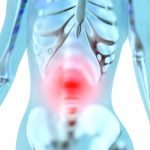Peripheral Neuropathy: Taking the Edge Off
CHRIS D. MELETIS, ND
Neuropathy is a painful condition characterized by numbness, prickling, burning, or other pain sensations, usually in the legs, feet, and hands. Two of the most common forms of neuropathy are diabetic peripheral neuropathy and chemotherapy-induced peripheral neuropathy. Diabetes is also the most common cause of autonomic neuropathy.1 Diabetic autonomic neuropathy is associated with symptoms and signs relating to nerve damage in the cardiovascular, urogenital, gastrointestinal, thermoregulatory, and ocular systems.1 Autonomic neuropathy should be suspected in patients with diabetic peripheral neuropathy, since the 2 complications often coexist.2 In this article, I’ll address the most common types of neuropathy and provide lifestyle and dietary supplement recommendations for ameliorating their symptoms.
Common Peripheral Neuropathies
Diabetic Peripheral Neuropathy
Diabetic peripheral neuropathy (DPN) is one of the most crippling consequences of diabetes mellitus, leading to pain, decreased mobility, and possibly foot ulcers and amputation.3 DPN is characterized by increased or decreased sensitivity to heat and touch, as well as pain that can vary from burning to prickling. Some patients may not experience symptoms, at least not initially. Diagnosis of asymptomatic diabetic neuropathy involves screening for physical signs including muscle weakness, muscle atrophy, partial shallow sensation loss of the limb, and/or weakened or disappearance of tendon reflexes, and conducting a neuroelectrophysiological examination.4 Neuropathy is present in an estimated 8% of newly diagnosed diabetes patients and more than half of all people with longstanding disease.5 Neuropathy may also occur in prediabetic conditions,6 while in other individuals it may take several years after diabetes onset for DPN to develop, as ongoing hyperglycemia progressively damages the nerves.3 Over the next 8 years, the prevalence of diabetic neuropathy is expected to increase by 5-fold due to the obesity epidemic, the concurrent increase in the incidence of type 2 diabetes, and its earlier onset.7
This disorder becomes a physical, mental, and economic burden. Standard treatments to manage symptoms, such as pain medications, anticonvulsants, and tricyclic antidepressants, are not always effective and few conventional treatments address the root cause.3,8
Diabetic Autonomic Neuropathy
Diabetic autonomic neuropathy (DAN) is a common complication of diabetes that can lead to serious consequences, such as cardiovascular mortality.9 The autonomic manifestations of diabetes play a significant role in the most worrisome and disabling consequences of DPN and are responsible for a substantial amount of the mortality and morbidity in diabetes.1 DAN may impact the gastrointestinal (GI), genitourinary, and cardiovascular systems.9 Patients with DAN can experience resting tachycardia, exercise intolerance, orthostatic hypotension, constipation, gastroparesis, erectile dysfunction, sudomotor (sweat gland) dysfunction, impaired neurovascular function, and hypoglycemic autonomic failure.9 Patients with DAN often suffer from GI problems including esophageal enteropathy, gastroparesis, constipation, diarrhea, and fecal incontinence.9 A full discussion of DAN is outside the scope of this article, but I wanted to acknowledge its existence and importance.
Chemotherapy-Induced Peripheral Neuropathy
Another common type of neuropathy is chemotherapy-induced peripheral neuropathy (CIPN), which occurs in more than 60% of people with cancer who are being treated with chemotherapy medications such as platinum derivatives (cisplatin, oxaliplatin), taxanes (paclitaxel, docetaxel), vinca alkaloids (vincristine, vinblastine), and bortezomib, ixabepilone, and thalidomide.10 Cisplatin, oxaliplatin, vincristine, paclitaxel, and bortezomib are the chemotherapy agents most likely to cause CIPN.11 In an estimated 20% to 30% of these patients, CIPN persists and becomes chronic after cancer treatment.10 CIPN symptoms include ongoing shooting, stabbing, or burning pain even when the patient is not exposed to painful stimuli.10 Patients with CIPN also experience a loss of sensation or numbness.10 The symptoms typically begin in the toes and fingers and then manifest in the legs and arms as CIPN progresses.10
Medication-Induced Neuropathy
A number of medications (besides chemotherapy drugs) can lead to peripheral neuropathy. These include certain drugs used for arrhythmia, high blood pressure, and HIV, as well as the statin class of drugs. See Table 1 for examples.
Table 1. Drugs That Can Cause Peripheral Neuropathy
| Condition | Medication |
| Hypercholesterolemia | Statin drugs |
| HIV | Zalcitabine, stavudine, didanosine |
| Malaria, autoimmune diseases | Chloroquine, hydroxychloroquine |
| Gout | Colchicine |
| Alcohol addiction | Disulfiram |
| Rheumatoid arthritis | Etanercept |
| Tuberculosis | Ethambutol, isoniazid |
| Bacterial infections | Fluoroquinolones antibiotics |
| High blood pressure | Hydralazine |
| Psoriasis, rheumatoid arthritis | Leflunomide |
| Rosacea | Metronidazole |
| Urinary tract infections | Nitrofurantoin |
| Seizures | Phenytoin |
| Arrhythmia | Procainamide, amiodarone |
Lifestyle Interventions
As the saying goes, an ounce of prevention is worth a ton of cure. There are factors that increase a person’s risk of developing both CIPN and DPN, as well as exacerbate preexisting neuropathy. These factors include obesity, smoking, and excessive alcohol use.11 Controlling these 3 factors can go a long way toward improving patients’ nerve health. Likewise, it is becoming increasingly clear that metabolic syndrome (aka prediabetes) is linked to neuropathy.13 Animal models and epidemiologic and clinical studies indicate that metabolic syndrome – along with its components, including obesity, lipid imbalances, and insulin resistance – is involved in the pathophysiology of neuropathy.13 Specifically, impaired glucose tolerance and metabolic syndrome are associated with subclinical nerve damage.13
Therefore, strategies like encouraging patients to eat a low-glycemic-load diet to enhance metabolic health can be effective. In this regard, urging patients to exercise is also important. Recent evidence indicates that targeted lifestyle alterations, including aerobic exercise and diet modifications that lead to weight loss, may inhibit the natural course of diabetic peripheral neuropathy and possibly other types of neuropathy as well.14 In one study of 1648 patients, participating in less than 150 minutes of moderate-to-vigorous physical activity weekly significantly correlated with CIPN-like symptoms among those not treated with chemotherapy, as well as more CIPN among the 506 patients who had been treated with chemotherapy.15 Aerobic exercise leads to beneficial effects in many of the pathogenic pathways involved in neuropathy. In both animal models and human trials, exercise reduced neuropathy symptoms and promoted regrowth of cutaneous small-diameter nerve fibers.16
Neuropathy & the Mitochondria
Mitochondria are rod-shaped cellular organelles that serve as the cells’ batteries. Thanks to the mitochondria, oxygen and nutrients are converted into cellular energy in the form of adenosine triphosphate (ATP). In neuronal cells, mitochondrial oxidative phosphorylation is responsible for synthesizing more than 90% of the ATP needed for maintenance of normal cellular function.10
Neuronal mitochondrial dysfunction and the resulting nitro-oxidative stress are important factors involved in the pathogenesis of CIPN.10 In CIPN, the inability of the mitochondria to generate sufficient levels of ATP for neuronal activities that require high energy is considered to be a primary mechanism underlying this type of neuropathy.17 There is a vicious circle whereby impaired mitochondrial function leads to nitro-oxidative stress and oxidative damage to mitochondrial DNA and proteins, which in turn further exacerbates mitochondrial injury and causes sensory neurons to run out of energy to function properly.18 Diabetic neuropathy is also associated with mitochondrial damage to dorsal root ganglion neurons, axons, and Schwann cells.19-21
Fueling our nerve cells with nutrients that protect the mitochondria can represent a good strategy for inhibiting neuropathy. One of these nutrients is nicotinamide riboside (NR), a form of vitamin B3. NR is a precursor of nicotinamide adenine dinucleotide (NAD), a coenzyme essential to the mitochondria’s energy-generating process. In diabetic peripheral neuropathy, a pathway dependent upon NAD+ is impaired.7 A number of preclinical studies found that NR can prevent and reverse DPN as well as neuropathy in prediabetes.7,22 In prediabetic mice, NR also enhanced glucose tolerance and reduced weight gain, liver damage, and the development of hepatic steatosis.22 In mice with type 2 diabetes, NR significantly lowered non-fasting and fasting blood glucose, reduced weight gain, and inhibited hepatic steatosis.22 Both of these studies indicate that NR can be highly useful in metabolic control. NR accomplishes its beneficial effects by increasing NAD+ concentrations and also levels of the protein Sirtuin 1, which is involved in regulating insulin sensitivity and longevity.7
Furthermore, in 2 rodent studies, NR was found to inhibit CIPN caused by the chemotherapy drug, paclitaxel.23,24 NR, given as 200 mg/kg starting a week before the beginning of paclitaxel treatment and continued for another 24 days, blocked the development of tactile hypersensitivity. Blood concentrations of NAD increased by 50% during NR treatment. Importantly, NR did not interfere with the effects of paclitaxel.23 In fact, in one of the studies, NR decreased tumor growth when used as an adjunct treatment with paclitaxel.24
NR can be used together with alpha-lipoic acid and coenzyme Q10 (CoQ10) – 2 well-known mitochondrial rejuvenating nutrients. Alpha-lipoic acid (ALA) has been shown to block mitochondrial injury and in some studies to inhibit the development of CIPN.25,26 For diabetic neuropathy, a number of randomized, double-blind, placebo-controlled clinical trials and meta-analyses indicate that ALA is effective and safe, yielding clinically significant improvements.25 According to the authors of one review, “When compared with currently licensed analgesic drugs, [ALA] is better tolerated, has a more rapid onset of action, and improves paraesthesiae, numbness, sensory deficits, and muscle strength in addition to neuropathic pain. In clinical practice, ALA may be chosen in patients with early neuropathic deficits and symptoms, in whom clinical improvement is more likely.”25
In patients with diabetic polyneuropathy, the ubiquinone form of CoQ10, given at 400 mg daily for 12 weeks in a randomized, double-blind, placebo-controlled trial, led to improvement in clinical outcomes and nerve conduction parameters.27 In experimental diabetic neuropathy, a combination of CoQ10 and ALA reduced the degeneration of dorsal root ganglion neurons and increased ATP production. 28
The Microcirculation’s Role in Neuropathy
If we pinch a nerve or sleep wrong on our arm, lack of nerve impulses or circulation can cause our nerves to complain. Often this is caused by disrupted microcirculation, which plays an integral role in neuropathy.29 The microvascular system is composed of small blood vessels including arterioles, capillaries, and venules. Animal studies suggest that in diabetics, microvessel integrity is weakened due to hyperglycemia.29 Nitric oxide (NO) bioavailability is critical to a healthy microvascular system,30-32 and NO can help regulate microvascular blood flow.33 Eating a diet rich in dietary nitrates or supplementing with NO donors can enhance the health of this system. However, the age-related or disease-induced drop in NO is extensive enough that eating a nitrate-rich diet including vegetables is not always sufficient to raise NO levels. Plus, how many of our patients are eating the recommended 2 ½ to 3 servings of vegetables daily?
In rodent studies of experimental diabetes, supplementing with nitrate protected against DPN and conferred metabolic benefits.29,33 Nitrate also beneficially modified thermal and mechanical sensitivities.33
Our good friend, vitamin D, can be utilized together with a nitrate-rich supplement to enhance microcirculation in people with neuropathy. A study of 62 patients with type 2 diabetes and peripheral neuropathy compared the effects of 5000 IU of vitamin D3 per week with 40 000 IU/week for 24 weeks.34 The study authors observed vitamin D deficiency/insufficiency in 78% of the participants. The subjects given 40 000 IU/week experienced a decline in neuropathy severity, improved microcirculation, and reduced inflammation. No effects were noted in the 5000 IU/week group.34
The Gut Microbiota
As noted earlier in this article, there is a strong link between metabolic syndrome and neuropathy. Alterations in the gut microbiome are associated with both metabolic syndrome and diabetes.35 These alterations in the gut microbiome can occur due to increased intestinal permeability resulting from dietary and environmental factors as well as chronic mental stress, which in turn increase glucose intolerance.35 Given that the root cause of DPN is diabetes and dysregulated blood sugar metabolism, addressing disturbances in the gut microbiota can improve metabolic imbalances that would otherwise lead to prediabetes and diabetes.
Gut microbiome dysbiosis is known to be involved in the pathogenesis of diabetic microvascular complications including neuropathy.36 Therefore, incorporating a good probiotic into patients’ supplement regimens is highly beneficial. Probiotics may also be useful in CIPN. Rodent research found that a probiotic formulation prevented the neuropathy-related mechanical and cold hypersensitivity in paclitaxel-treated mice.37 The probiotic also blocked nerve fiber injury in the paws of the animals and reduced the concentration of serum proinflammatory cytokines.
Additional Supplement Considerations
A number of other dietary supplements have been shown to be beneficial in neuropathy in human trials and/or animal studies.
Cannabidiol
Cannabidiol (CBD) is a non-psychoactive component of Cannabis sativa that has been shown to modify neuronal activity.38 Various rodent models indicate that oral, intraperitoneal, and intranasal CBD administration can suppress both CIPN and DPN.39-42 For example, in a study of female mice, CBD prevented both the cold and mechanical allodynia (sensitivity to cold temperatures and touch) triggered by the chemotherapy agent paclitaxel.40 In a human randomized, placebo-controlled, crossover trial of patients with peripheral neuropathy, topical CBD significantly reduced intense pain, sharp pain, and cold and itchy sensations compared to the placebo group.43 CBD works through the endocannabinoidome, indicating that its effects extend beyond direct interactions with the endocannabinoid system. Specifically, its beneficial effects on neuropathy occur through the serotonin 5-HT1A receptor and the transient receptor potential cation channel, TRPV1.38
Palmitoylethanolamide
Palmitoylethanolamide (PEA) is a fatty acid amide that has a promising role to play in the treatment of chronic pain from DPN and CIPN, as well as carpal tunnel syndrome, sciatic pain, osteoarthritis, low back pain, failed back surgery syndrome, dental pain, neuropathic pain due to stroke and multiple sclerosis, chronic pelvic pain, and post-herpetic neuralgia.44 Preclinical animal studies have found it effective for neuropathic pain, and human studies have supported its efficacy in various types of painful disorders.44 PEA is thought to work primarily through the peroxisome proliferator-activated receptor alpha (PPAR-α), which regulates gene networks that control pain and inflammation.45 PEA also interacts with the cannabinoid-like G-protein-coupled receptors GPR55 and GPR119.46
B Vitamins
Vitamin B12 deficiency is associated with peripheral neuropathy, and supplementation may prove supportive,47 although not all studies have indicated benefit.8 One review found that a combination of B vitamins as well as pure methylcobalamin improved pain and paresthesia; in 3 of the reviewed studies, methylcobalamin therapy also improved autonomic symptoms.48 Many patients with DPN are taking the medication metformin, which can lead to vitamin B12 deficiency.49 In addition, alcoholism, bariatric surgery, or anorexia can result in deficiencies of vitamin B6 and thiamine and the ensuing development of polyneuropathy.50
Omega-3 Fatty Acids
The phospholipid membrane of cells, including those of the central and peripheral nervous systems, are rich in omega-3 fatty acids such as eicosapentaenoic acid (EPA) and docosahexaenoic acid (DHA).51 Some evidence indicates that supplementation with omega-3s may be beneficial for people suffering from neuropathy. One double-blind, randomized, controlled study investigated the use of omega-3 fatty acids in breast cancer patients undergoing chemotherapy with paclitaxel.52 The patients were given 640 mg (DHA-54%; EPA-10%) 3 times daily or placebo during chemotherapy and for 1 month afterward. There was a 70% lower risk of peripheral neuropathy in the omega-3 fatty acid group.
Vitamin E
Vitamin E has reduced CIPN in a number of studies, although the results seem to depend on the chemotherapy agent used. In a study investigating the use of 300 mg twice daily of alpha-tocopherol during cisplatin treatment and for 3 months afterward, patients in the control group were more likely to develop cisplatin-induced peripheral neuropathy compared to the vitamin E group.53 Similar results were achieved in other studies of patients undergoing chemotherapy with either paclitaxel or cisplatin.54,55 However, studies using the chemotherapy drug oxaliplatin, which is more aggressive because it escapes DNA repair systems, found no effect of vitamin E.56
Dietary Supplement Summary
To recap, the following dietary supplements have been found to be beneficial in various types of peripheral neuropathy:
- Nicotinamide riboside
- Alpha-lipoic acid
- CoQ10 (see comment in next section)
- A nitrate-rich supplement
- Vitamin D
- Probiotics
- CBD
- PEA
- B vitamins
- Omega-3 fatty acids
- Vitamin E
Nutrients to Use With Caution
In a number of studies, including clinical trials, acetyl-L-carnitine (ALC) supplementation led to improvements in CIPN.57,58 However, recent studies not only found ALC was ineffective; it also exacerbated CIPN.59,60 Furthermore, in a study of HIV patients, CoQ10 treatment increased well-being in asymptomatic patients as well as in control subjects; however, it exacerbated pain in HIV-patients with medication-induced peripheral neuropathy.61 Finally, high intake of vitamin B6 may increase the risk of peripheral neuropathy.62
Conclusion
Peripheral neuropathy is a debilitating condition that can rob patients of their quality of life. Focusing on weight loss and metabolic control can lead to significant improvements in this group of patients. Moreover, supporting mitochondrial health with nicotinamide riboside, alpha-lipoic acid, and coenzyme Q10, and enhancing the microcirculation with a nitrate-rich supplement and vitamin D, can lead to beneficial results. Other dietary supplements, such as probiotics, CBD, PEA, B vitamins, omega-3 fatty acids, and vitamin E, are also important additions to a peripheral neuropathy regimen. Finally, it is important to be cautious of ALC, CoQ10, and too high a dose of vitamin B6, as some studies indicate this may worsen neuropathic symptoms.
References:
- reeman R. Diabetic autonomic neuropathy. Handb Clin Neurol. 2014;126:63-79.
- Vinik AI, Nevoret ML, Casellini C, Parson H. Diabetic neuropathy. Endocrinol Metab Clin North Am. 2013;42(4):747-787.
- Dewanjee S, Das S, Das AK, et al. Molecular mechanism of diabetic neuropathy and its pharmacotherapeutic targets. Eur J Pharmacol. 2018;833:472-523.
- Guan H, Ye M, Fang C, et al. The clinical effectiveness and safety of alprostadil combined with alpha lipoic acid in the treatment of diabetic peripheral neuropathy: A protocol for systematic review and meta-analysis. Medicine (Baltimore). 2020;99(50):e23507.
- Edwards JL, Vincent AM, Cheng HT, Feldman EL. Diabetic neuropathy: mechanisms to management. Pharmacol Ther. 2008;120(1):1-34.
- Singleton JR, Smith AG, Russell J, Feldman EL. Polyneuropathy with Impaired Glucose Tolerance: Implications for Diagnosis and Therapy. Curr Treat Options Neurol. 2005;7(1):33-42.
- Chandrasekaran K, Anjaneyulu M, Choi J, et al. Role of mitochondria in diabetic peripheral neuropathy: Influencing the NAD(+)-dependent SIRT1-PGC-1α-TFAM pathway. Int Rev Neurobiol. 2019;145:177-209.
- Jayabalan B, Low LL. Vitamin B supplementation for diabetic peripheral neuropathy. Singapore Med J. 2016;57(2):55-59.
- Vinik AI, Maser RE, Mitchell BD, Freeman R. Diabetic autonomic neuropathy. Diabetes Care. 2003;26(5):1553-1579.
- Ma J, Kavelaars A, Dougherty PM, Heijnen CJ. Beyond symptomatic relief for chemotherapy-induced peripheral neuropathy: Targeting the source. Cancer. 2018;124(11):2289-2298.
- Boyette-Davis JA, Hou S, Abdi S, Dougherty PM. An updated understanding of the mechanisms involved in chemotherapy-induced neuropathy. Pain Manag. 2018;8(5):363-375.
- Foundation for Peripheral Neuropathy. https://www.foundationforpn.org/what-is-peripheral-neuropathy/causes/other-drugs/. Accessed May 18, 2021.
- Cortez M, Singleton JR, Smith AG. Glucose intolerance, metabolic syndrome, and neuropathy. Handb Clin Neurol. 2014;126:109-122.
- Baute V, Zelnik D, Curtis J, Sadeghifar F. Complementary and Alternative Medicine for Painful Peripheral Neuropathy. Curr Treat Options Neurol. 2019;21(9):44.
- Mols F, Beijers AJ, Vreugdenhil G, et al. Chemotherapy-induced peripheral neuropathy, physical activity and health-related quality of life among colorectal cancer survivors from the PROFILES registry. J Cancer Surviv. 2015;9(3):512-522.
- Singleton JR, Smith AG, Marcus RL. Exercise as Therapy for Diabetic and Prediabetic Neuropathy. Curr Diab Rep. 2015;15(12):120.
- Bennett GJ, Doyle T, Salvemini D. Mitotoxicity in distal symmetrical sensory peripheral neuropathies. Nat Rev Neurol. 2014;10(6):326-336.
- Areti A, Yerra VG, Naidu V, Kumar A. Oxidative stress and nerve damage: role in chemotherapy induced peripheral neuropathy. Redox Biol. 2014;2:289-295.
- Chandrasekaran K, Anjaneyulu M, Inoue T, et al. Mitochondrial transcription factor A regulation of mitochondrial degeneration in experimental diabetic neuropathy. Am J Physiol Endocrinol Metab. 2015;309(2):E132-141.
- Fernyhough P. Mitochondrial dysfunction in diabetic neuropathy: a series of unfortunate metabolic events. Curr Diab Rep. 2015;15(11):89.
- Sifuentes-Franco S, Pacheco-Moisés FP, Rodríguez-Carrizalez AD, Miranda-Díaz AG. The Role of Oxidative Stress, Mitochondrial Function, and Autophagy in Diabetic Polyneuropathy. J Diabetes Res. 2017;2017:1673081.
- Trammell SA, Weidemann BJ, Chadda A, et al. Nicotinamide Riboside Opposes Type 2 Diabetes and Neuropathy in Mice. Sci Rep. 2016;6:26933.
- Hamity MV, White SR, Walder RY, et al. Nicotinamide riboside, a form of vitamin B3 and NAD+ precursor, relieves the nociceptive and aversive dimensions of paclitaxel-induced peripheral neuropathy in female rats. Pain. 2017;158(5):962-972.
- Hamity MV, White SR, Blum C, et al. Nicotinamide riboside relieves paclitaxel-induced peripheral neuropathy and enhances suppression of tumor growth in tumor-bearing rats. Pain. 2020;161(10):2364-2375.
- Papanas N, Ziegler D. Efficacy of α-lipoic acid in diabetic neuropathy. Expert Opin Pharmacother. 2014;15(18):2721-2731.
- Melli G, Taiana M, Camozzi F, et al. Alpha-lipoic acid prevents mitochondrial damage and neurotoxicity in experimental chemotherapy neuropathy. Exp Neurol. 2008;214(2):276-284.
- Hernández-Ojeda J, Cardona-Muñoz EG, Román-Pintos LM, et al. The effect of ubiquinone in diabetic polyneuropathy: a randomized double-blind placebo-controlled study. J Diabetes Complications. 2012;26(4):352-358.
- Sadeghiyan Galeshkalami N, Abdollahi M, Najafi R, et al. Alpha-lipoic acid and coenzyme Q10 combination ameliorates experimental diabetic neuropathy by modulating oxidative stress and apoptosis. Life Sci. 2019;216:101-110.
- Oghbaei H, Mohaddes G, Hamidian G, Keyhanmanesh R. Sodium nitrate preconditioning prevents progression of the neuropathic pain in streptozotocin-induced diabetes Wistar rats. J Diabetes Metab Disord. 2020;19(1):105-113.
- Barros-Santos E, de Oliveira GV, Volino-Souza M, Alvares TS. Dietary nitrate improves skeletal muscle microvascular oxygenation in HIV-infected patients receiving highly active antiretroviral therapy: a randomised, double-blind, cross-over, placebo-controlled study. Br J Nutr. 2020;124(12):1277-1284.
- Zafeiridis A, Triantafyllou A, Papadopoulos S, et al. Dietary nitrate improves muscle microvascular reactivity and lowers blood pressure at rest and during isometric exercise in untreated hypertensives. Microcirculation. 2019;26(3):e12525.
- Hobbs DA, Goulding MG, Nguyen A, et al. Acute ingestion of beetroot bread increases endothelium-independent vasodilation and lowers diastolic blood pressure in healthy men: a randomized controlled trial. J Nutr. 2013;143(9):1399-1405.
- Oghbaei H, Alipour MR, Mohaddes G, et al. Evaluation of ameliorative effect of sodium nitrate in experimental model of streptozotocin-induced diabetic neuropathy in male rats. Endocr Regul. 2019;53(1):14-25.
- Karonova T, Stepanova A, Bystrova A, Jude EB. High-Dose Vitamin D Supplementation Improves Microcirculation and Reduces Inflammation in Diabetic Neuropathy Patients. Nutrients. 2020;12(9):2518.
- Rowin J. Integrative neuromuscular medicine: Neuropathy and neuropathic pain: Consider the alternatives. Muscle Nerve. 2019;60(2):124-136.
- Tanase DM, Gosav EM, Neculae E, et al. Role of Gut Microbiota on Onset and Progression of Microvascular Complications of Type 2 Diabetes (T2DM). Nutrients. 2020;12(12):3719.
- Cuozzo M, Castelli V, Avagliano C, et al. Effects of Chronic Oral Probiotic Treatment in Paclitaxel-Induced Neuropathic Pain. Biomedicines. 2021;9(4):346.
- de Almeida DL, Devi LA. Diversity of molecular targets and signaling pathways for CBD. Pharmacol Res Perspect. 2020;8(6):e00682.
- King KM, Myers AM, Soroka-Monzo AJ, et al. Single and combined effects of Δ(9) -tetrahydrocannabinol and cannabidiol in a mouse model of chemotherapy-induced neuropathic pain. Br J Pharmacol. 2017;174(17):2832-2841.
- Ward SJ, Ramirez MD, Neelakantan H, Walker EA. Cannabidiol prevents the development of cold and mechanical allodynia in paclitaxel-treated female C57Bl6 mice. Anesth Analg. 2011;113(4):947-950.
- Jesus CHA, Redivo DDB, Gasparin AT, et al. Cannabidiol attenuates mechanical allodynia in streptozotocin-induced diabetic rats via serotonergic system activation through 5-HT1A receptors. Brain Res. 2019;1715:156-164.
- Toth CC, Jedrzejewski NM, Ellis CL, Frey WH, 2nd. Cannabinoid-mediated modulation of neuropathic pain and microglial accumulation in a model of murine type I diabetic peripheral neuropathic pain. Mol Pain. 2010;6:16.
- Xu DH, Cullen BD, Tang M, Fang Y. The Effectiveness of Topical Cannabidiol Oil in Symptomatic Relief of Peripheral Neuropathy of the Lower Extremities. Curr Pharm Biotechnol. 2020;21(5):390-402.
- Hesselink JM, Hekker TA. Therapeutic utility of palmitoylethanolamide in the treatment of neuropathic pain associated with various pathological conditions: a case series. J Pain Res. 2012;5:437-442.
- LoVerme J, Russo R, La Rana G, et al. Rapid broad-spectrum analgesia through activation of peroxisome proliferator-activated receptor-alpha. J Pharmacol Exp Ther. 2006;319(3):1051-1061.
- Naderi N, Majidi M, Mousavi Z, et al. The interaction between intrathecal administration of low doses of palmitoylethanolamide and AM251 in formalin-induced pain related behavior and spinal cord IL1-β expression in rats. Neurochem Res. 2012;37(4):778-785.
- Head KA. Peripheral neuropathy: pathogenic mechanisms and alternative therapies. Altern Med Rev. 2006;11(4):294-329.
- Sun Y, Lai MS, Lu CJ. Effectiveness of vitamin B12 on diabetic neuropathy: systematic review of clinical controlled trials. Acta Neurol Taiwan. 2005;14(2):48-54.
- Liu KW, Dai LK, Jean W. Metformin-related vitamin B12 deficiency. Age Ageing. 2006;35(2):200-201.
- Hamel J, Logigian EL. Acute nutritional axonal neuropathy. Muscle Nerve. 2018;57(1):33-39.
- Brami C, Bao T, Deng G. Natural products and complementary therapies for chemotherapy-induced peripheral neuropathy: A systematic review. Crit Rev Oncol Hematol. 2016;98:325-334.
- Ghoreishi Z, Esfahani A, Djazayeri A, et al. Omega-3 fatty acids are protective against paclitaxel-induced peripheral neuropathy: a randomized double-blind placebo controlled trial. BMC Cancer. 2012;12:355.
- Argyriou AA, Chroni E, Koutras A, et al. A randomized controlled trial evaluating the efficacy and safety of vitamin E supplementation for protection against cisplatin-induced peripheral neuropathy: final results. Support Care Cancer. 2006;14(11):1134-1140.
- Argyriou AA, Chroni E, Koutras A, et al. Preventing paclitaxel-induced peripheral neuropathy: a phase II trial of vitamin E supplementation. J Pain Symptom Manage. 2006;32(3):237-244.
- Pace A, Giannarelli D, Galiè E, et al. Vitamin E neuroprotection for cisplatin neuropathy: a randomized, placebo-controlled trial. Neurology. 2010;74(9):762-766.
- Afonseca SO, Cruz FM, Cubero Dde I, et al. Vitamin E for prevention of oxaliplatin-induced peripheral neuropathy: a pilot randomized clinical trial. Sao Paulo Med J. 2013;131(1):35-38.
- Maestri A, De Pasquale Ceratti A, Cundari S, et al. A pilot study on the effect of acetyl-L-carnitine in paclitaxel- and cisplatin-induced peripheral neuropathy. Tumori. 2005;91(2):135-138.
- Sima AA, Calvani M, Mehra M, Amato A. Acetyl-L-carnitine improves pain, nerve regeneration, and vibratory perception in patients with chronic diabetic neuropathy: an analysis of two randomized placebo-controlled trials. Diabetes Care. 2005;28(1):89-94.
- Hershman DL, Unger JM, Crew KD, et al. Randomized double-blind placebo-controlled trial of acetyl-L-carnitine for the prevention of taxane-induced neuropathy in women undergoing adjuvant breast cancer therapy. J Clin Oncol. 2013;31(20):2627-2633.
- Callander N, Markovina S, Eickhoff J, et al. Acetyl-L-carnitine (ALCAR) for the prevention of chemotherapy-induced peripheral neuropathy in patients with relapsed or refractory multiple myeloma treated with bortezomib, doxorubicin and low-dose dexamethasone: a study from the Wisconsin Oncology Network. Cancer Chemother Pharmacol. 2014;74(4):875-882.
- Rabing Christensen E, Stegger M, Jensen-Fangel S, et al. Mitochondrial DNA levels in fat and blood cells from patients with lipodystrophy or peripheral neuropathy and the effect of 90 days of high-dose coenzyme Q treatment: a randomized, double-blind, placebo-controlled pilot study. Clin Infect Dis. 2004;39(9):1371-1379.
- Hadtstein F, Vrolijk M. Vitamin B-6-Induced Neuropathy: Exploring the Mechanisms of Pyridoxine Toxicity. Adv Nutr. 2021 Apr 29:nmab033. doi: 10.1093/advances/nmab033. [Epub ahead of print]

Chris D. Meletis, ND is an educator, international author, and lecturer. He has authored 18 books and more than 200 scientific articles in prominent journals and magazines. Dr Meletis served as Dean of Naturopathic Medicine and CMO for 7 years at NUNM. He was recently awarded the NUNM Hall of Fame award by OANP, as well as the 2003 Physician of the Year by the AANP. Dr Meletis spearheaded the creation of 16 free natural medicine healthcare clinics in Portland, OR. Dr Meletis serves as an educational consultant for Fairhaven Health, Berkeley Life, TruGen3, US BioTek, and TruNiagen. He has practiced in Beaverton, OR, since 1992.










